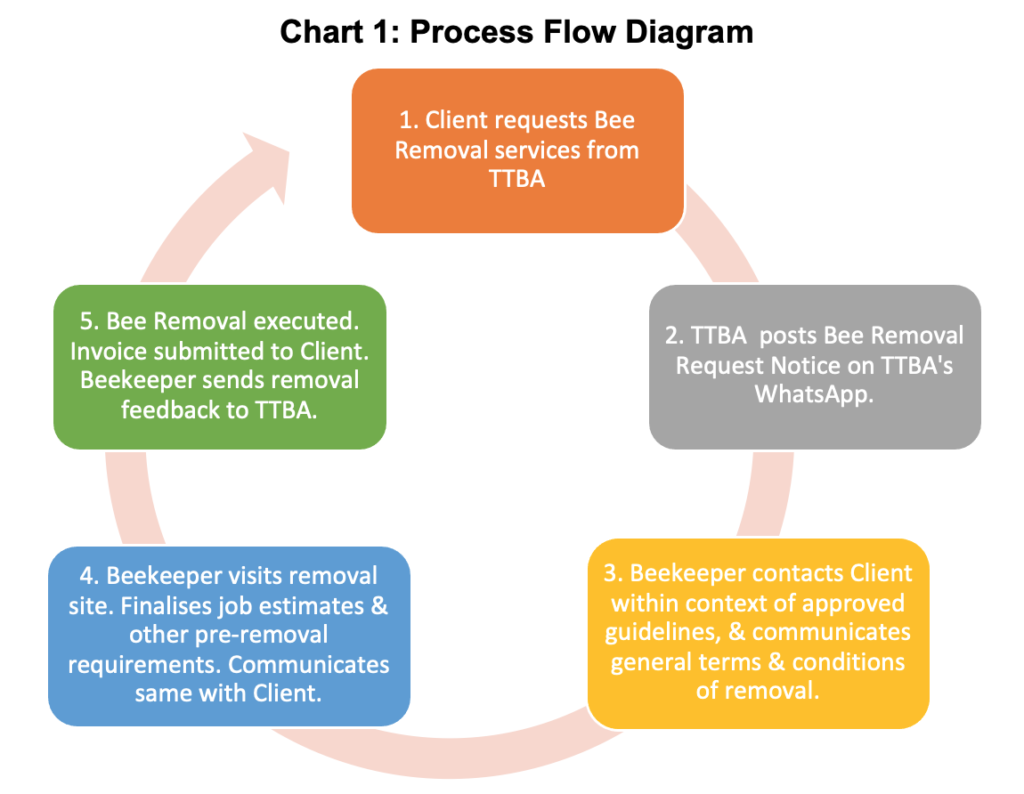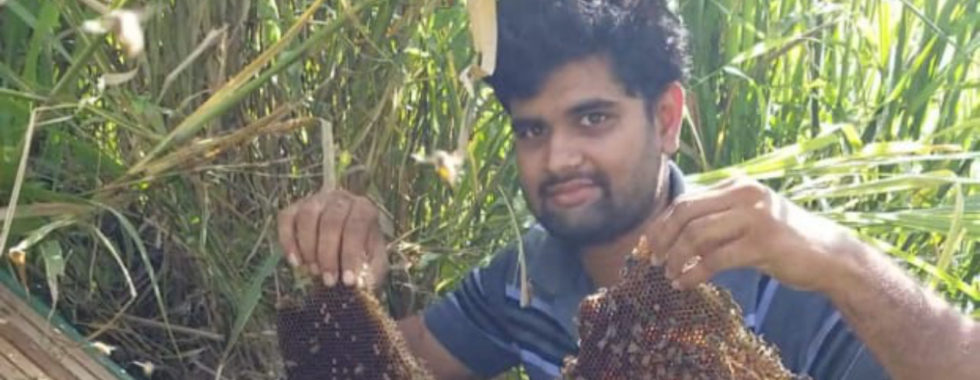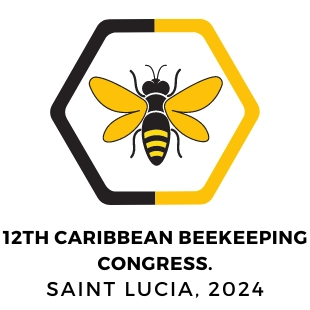Enhancing Africanised Bee Removals in Trinidad and Tobago
The arrival of Africanised honeybees in Trinidad, the most southerly island in the Caribbean, is undoubtedly the biggest game changer in the island’s beekeeping history. The first established colony was found on July 1979 in county St. Patrick in south-eastern Trinidad. Annual reports from the Ministry of Agriculture indicate that a succession of swarms arrived from South America (seven miles away) and irreversibly changed beekeeping as it was previously known.
To date, the honeybees on Tobago, Trinidad’s counterpart in the twin island Republic, are of the same variety introduced by European colonist. This is on account of the de facto prohibition on the movement of bees from Trinidad to Tobago since the arrival of Africanised bees in the former, Tobago’s location 35 kilometres up-wind of Trinidad, and the nature of passenger and cargo traffic between both islands which limit the possibility of undetected transportation of honeybee colonies.
Africanised honeybee colonies poise a heightened challenge to public safety, particularly in urban areas, given their higher propensity to swarm and abscond, and to be defensive, compared to their European counterpart. Their arrival precipitated a decline in Trinidad’s beekeeping sector and marked the end of the parallel development of beekeeping on both islands. There were significant reductions in both the number of colonies and beekeepers in the aftermath of the bee’s arrival. More than half of the practicing beekeepers in 1978 had given up beekeeping by 1984 because of the bee’s high swarm frequency and extreme defensive nature.[1]
Over 28,000 established feral colonies were destroyed or collected by the Ministry of Agriculture’s Bee Abatement Programme, and at least 5,300 persons and 800 plus animals had been stung by honeybees during the period 1979 to August 1992. By December 2005, 16 persons in Trinidad died because of stings from Africanised bees.
The emergence of a new generation of beekeepers around the turn of the century with no prior exposure to the easier-to-manage European honeybees, and no option but to work with the available stock of Africanised honeybees, heralded the start of the resuscitation of beekeeping on the island. Hayden Sinanan, Inspector of Apiaries, estimates that currently there 400 active beekeepers (roughly the same number reported in 1978), managing approximately 9000 colonies (almost 2,000 more than was reported in 1978) in Trinidad.
The removal of honeybee swarms or established colonies from locations other than managed apiaries, has always been integral to beekeeping. Bee removals were provided by the Ministry of Agriculture as a public service prior to, and more so since the arrival of the Africanised honeybees. As beekeepers gained confidence in managing Africanised bees, their involvement in bee removals and the commercialisation of the activity accelerated. In fact, bee removal has emerged as a specialised economic activity within the sector, with several beekeepers investing in related equipment and paraphernalia such as bee vac’s, scaffolding, ladders, and the like. This development has been facilitated in part by constraints in the delivery of bee removal services by the Ministry’s Bee Abatement Unit.
The Trinidad and Tobago Beekeepers’ Association (TTBA) received 352 requests for bee removals between 1st May 2019 and 20th June 2020, with the highest percentage of calls received in May and June, and October and November. Khannaya Baboolal, Head of Apiaries at the Ministry of Agriculture, North Regional Office informed that over the past year his office received an average of 150 removal calls per month with a data variance skewed towards more calls in the rain season (the second half of the year). Allan Mahabir, Administrative Officer at the Ministry’s South Regional Office reported a similar pattern of removal calls, with a monthly average of 70. Bee removal calls were also received by the other two beekeeping associations in Trinidad, pest removal companies, the Trinidad and Tobago Electricity Commission (T&TEC), and individual beekeepers. Taken together, an estimated 3,600 bee removal calls were received from all sources over the past year.
The Inspector of Apiaries endorsed the estimated number of removal calls received. He referenced a study undertaken by the Ministry of Agriculture in 2005 which quantified annual bee removal requests at approximately 1,000, and noted that the current estimated number of removal calls may be because of the improved methods of communication resulting in more calls being made, urbanisation, and increases in the number of managed and feral honeybee colonies on the island.
Aditya Ramlochan, a beekeeper from Manzanilla on Trinidad’s east coast estimates that he removed over 1,000 colonies since he started bee removals in 2001. Aditya recalled that in 2019 he removed 120 swarms, and about 100 the previous year. Those were bumper years as he previously averaged 50 – 60 removals per year. Referred to by his peers as the “bee whisperer” because of his deft bee-handling and bee removal skills, Aditya anticipates that he will remove more than 100 swarms by year’s end.
Clients requesting bee removal services from the TTBA during daylight hours could expect to be contacted by a beekeeper within ten minutes of making the request. Where there is agreement on the terms and conditions, and depending on the complexity of the removal, same is usually effected within 24 hours.
Even so, there has been increasing reports of misconceptions in Clients’ expectations regarding bee removal services. Some clients are of the view that they are entitled to the honey removed as part of the process. Petra Rattan from Matura, a home-schooling mother and beekeeper with over five-year’s experience, remedied this situation by including on her removal estimate form that clients are required to sign, a statement which reads, “when we agree to remove bees from your premises it is our aim to safely relocate them. A successful colony requires bees, comb, honey, and pollen, as such all of the aforementioned are considered part of the removal process.”
Some clients believe they are doing the beekeeper a favour by allowing him/her to remove bees from their property and as such they should not be required to pay for removal services. There are, however, genuine cases where clients are not able to pay removal fees. Kern Cyrus from Chaguanas in central Trinidad has had encounters with such clients over the four years he has been doing bee removals. Kern does not see removals as strictly a business. He informed that “in instances where I realise the Client is unable to pay, I removed the swarm anyway, sometimes at a reduced rate, it puts me in a position to help persons who often are under siege or feel threatened by a swarm of bees, it’s my way of contributing to the wider community in my capacity as a beekeeper”.
Recognising the need to improve service delivery and customer education, a Team of volunteers from the TTBA comprised mainly of persons involved in bee removals embarked on a mission, endorsed by the TTBA’s Executive, to draft proposals to enhance the Association’s bee removal portfolio, inclusive of a fee structure.
The Team met on several occasions over a ten-week period via the Zoom platform, and otherwise communicated via WhatsApp. Its final report was recently submitted to the TTBA’s Executive, inclusive of the following recommendations:
- Enhance the current line of communication between the public and the TTBA regarding reporting of bee removals, through consistent educational outreach programmes via social media, television, radio and newspapers.
- Amend the Process Flow for bee removal requests to comply with the 5-Step Diagram at Chart 1.

- Form an exclusive WhatsApp Group, administered by the TTBA’s Executive, to treat with Bee Removals. Conditions for inclusion and retention in the Group are as follows:
- Financial membership in the TTBA.
- Practical skill and knowledge levels established by the TTBA.
- Agreement to abide by a Code of Conduct and other requirements approved by the TTBA.
- Organise at least one workshop/course per year that covers the skill & knowledge required for inclusion in the Bee Removers WhatsApp Group.
- Adopt the attached professionally drafted Bee Removal Contract Agreement for use as the authorised agreement document between Beekeepers and Clients.
- Follow-up on discussions initiated by the Team with T&TEC and pests removal companies regarding establishing strategic alliances to treat with bee removals.
- Approve the implementation of the following Bee Removal Fee Structure.
BEE REMOVAL FEE STRUCTURE
| CATEGORIES (Assess the removal & circle one numerical value in each category) |
ASSESSMENT SCORE | |||||
| REMOVAL TIME | RISK | SKILL LEVEL | ||||
| Less than 1 hour |
1 |
Low |
1 |
Basic |
1 |
|
| 1 to 2 hours |
2 |
Medium |
2 |
Moderate |
2 |
|
| 2 to 3 hours |
3 |
High |
3 |
Mildly Complex |
3 |
|
| 3 to 4 hours |
4 |
Very High |
4 |
Complex |
4 |
|
| More than 4 hours | Extremely High | Very Complex | ||||
| TOTAL ASSESSMENT SCORE | ||||||
A pre-determined fee is fixed for each assessment point, e.g. $100. An Assessment Score of 3 = $300.
The Structure provides pre-determined fees for Assessment Scores ranging from 3 to 12 points.
Fees for Assessment Scores above 12 are determined by the Beekeeper.
[1] Mohamed K. Hallim “Beekeeping Industry in Trinidad and Tobago in the year 2000” (paper presented at the Second Caribbean Beekeeping Congress, Gingerland, Nevis, August 14-18, 2000).nd


